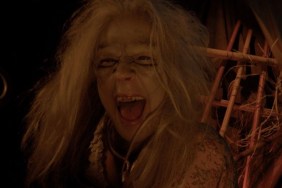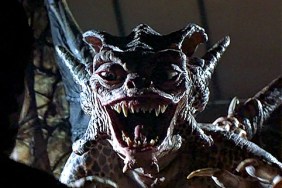Horror’s urban anthology film

No one trick or treats on the last day of school, no one carves jack o’ lanterns on July 4th, or goes on haunted hayrides in August.
When it comes to beloved macabre traditions, the fall is the season that gets all the attention. Thanks to the celebration of Halloween, the autumn months have always been indelibly associated with all things frightful. Summer, on the other hand, is ostensibly all that horror isn’t about â a golden time of warm weather, trips to the beach, fireworks, road trips and family picnics.
For those movie buffs that prefer the inside of their neighborhood cinemas (or, for some, the nighttime chill of drive-in theaters) to the blistering heat, however, the summer is the real witching season. Some believe that horror vacations in summer, waiting for fall to arrive, but box office history tells a different story.
Starting in 1975 when Jaws invented the modern blockbuster by teaching a generation to be afraid of the ocean, summer has been the best time of year to be scared. The fall can keep Halloween. It can keep the costumes, the candy, the Great Pumpkin, all of it â because summer has always had the better movies.

I should be using this space to talk about Species, the sexy sci-fi shocker that was a surprise hit in the summer of ’95 but when it comes to that summer, my heart is in the Hood.
In the tradition of such Amicus anthologies of the ’60s and ’70s as Dr. Terror’s House of Horrors (1964), Asylum (1972) and their E.C. Comics adaptations Tales from the Crypt (1972) and The Vault of Horror (1973), Tales from the Hood was a collection of four supernatural tales. The twist, as its title suggests, is that these tales of terror were tied together by racial themes and inner city settings. Executive produced by Spike Lee, produced and co-written by Darin Scott (who previously produced another notable horror anthology, 1987’s The Offspring), and co-written and directed by Rusty Cundieff, Tales from the Hood was a ghoulish good time that balanced its shocks with sermonizing and social insight.
The film opens in South Central L.A. with three young drug dealers â Stack (Joe Torry), Ball (De’aundre Bonds), and Bulldog (Samuel Monroe, Jr.) â advancing on the eerie edifice of Simms’ Funeral Home (as Ball says, “Damn, that place does look evil as Hell!”). They’ve come to purchase some drugs that the home’s eccentric director, Mr. Simms (Clarence Williams III, in a genius performance that rewrites the book on overacting), claims to have found in an alley. But collecting “the shit” as they call it isn’t the easy transaction they were hoping for. Mr. Simms asks the three hoods to give him a hand with the stash of drugs that he’s stowed away in the basement (“Don’t worry â you’ll get the shit! You’ll be knee-deep in the shit! I’ve got it hid. There’s so much I couldn’t even lift it all myself.”). Along the way, Mr. Simms stops to tell the increasingly impatient threesome tales about the bodies in his care that seem too strange to be true.
First, there’s “Rogue Cop Revelation,” the story of Clarence Smith (Anthony Griffith) a black cop who witnesses the beating and murder of Martin Moorehouse (Tom Wright), a city councilman and black rights activist, at the hands of a trio of his fellow policemen (Duane Whitaker, Wings Hauser and Michael Massee). Because Clarence is a rookie, he’s too afraid to come forward against these senior officers. Eventually Moorehouse himself comes back from the grave to settle his own scores but the officers that ended his life aren’t the only ones who need to be afraid of his return.

Every horror anthology worth its salt has to include a vengeance from the grave story and “Rogue Cop Revelation” kicks off Tales from the Hood in classic style while making its political passions clear. Not only are the rogue cops marked for death, but the weak-willed Clarence who fails to call them out is also subject to Moorehouse’s wrath. That wrath is brought to life by KNB (whose founders, years earlier, were responsible for making Wright into the hitchhiker in Creepshow 2 â “Thanks for the ride, lady!”). Their best effect for the episode involves the death of a character that melts and morphs into a graffiti illustration, a much nastier effect than most horror films at the time were able to put on screen without MPAA interference.
Next up is “Boys Do Get Bruised,” a grim tale of child abuse. Director Cundieff steps in front of the camera to play Richard Garvy, a concerned elementary school teacher who investigates the bruises he sees on the arm of one his students, Walter (Brandon Hammond). Walter claims it was a monster that caused the bruises but as Garvy discovers, Walter is being abused by a more real-world monster, his bullying stepfather Carl (David Alan Grier, fearsomely convincing in this non-comic role). Will this well-meaning teacher be able to intervene in time or will it be Walter’s uncanny psychic abilities that offer him a way out of his torment?
“Boys Do Get Bruised” is an uncomplicated story, made memorable thanks to Grier’s unnerving performance as well a grisly punchline served courtesy of the FX wizardy of Screaming Mad George. This effect, involving Grier’s character literally being folded and crumpled like a sheet of paper, is a marvel of old-school FX. It would’ve been more expedient, surely, to resort to CGI for this sequence but SMG found a way to accomplish it through practical means and it’s an illusion that never fails to impress; it remains one of the best horror movie deaths ever â both comic and horrifying (punctuated by Grier’s hilariously defiant last line “This shit ain’t done yet, bitch!”).

“KKK Comeuppance,” Mr. Simms’ third story, involves the retribution visited on a David Duke-styled Southern senator (and former KKK member), Duke Metzger (played with slimy charisma by L.A. Law‘s Corbin Bernsen) as his campaign for governor hits a supernatural snag. Living in what was once a former slave plantation, a painting hangs prominently on a wall in Metzger’s new home depicting an old voodoo witch, Mrs. Cobbs, surrounded by the dozens of dolls she crafted which reportedly housed the souls of dead slaves killed in a massacre. After Metzger’s assistant is killed in a fall down a staircase (caused by stepping on one of the voodoo witch’s dolls), he discovers that the myth of the dolls isn’t just a story as they disappear from the painting’s canvas and come to exact revenge upon this unrepentant racist in person.
With its living doll action affectionately pinched from another anthology classic, “Prey,” from the 1975 TV movie Trilogy of Terror, “KKK Comeuppance” is another example of Tales from the Hood saluting the films that inspired it while being more than just a simple homage. The dolls in this segment are the creation of the Chiodo Brothers (Killer Klowns from Outer Space) and with their unnervingly crude features â faces that manage to look both lumpy and emaciated â and stop motion movements, they’re a frequently cited highlight of the film.
The fourth and final story is “Hard Core Convert,” the story of Crazy K, aka Jerome John (Lamont Bentley), a gang member who is shot by three assailants while in pursuit of one of his many enemies. Crazy K recovers from his life-threatening injuries but is sent to prison, after which Dr. Cushing (Rosalind Cash, whose character name here is a nod to Amicus regular Peter Cushing) arrives to transfer Crazy K to the fortress-like facility that she runs. There, Dr. Cushing submits Crazy K to a Clockwork Orange-style treatment of psychological deprogramming in which the violent Crazy K is forced, while restrained in torturous devices, to endure images of the murder of blacks at the hands of white racists as well as at the hands of modern day gang members like himself.
Perpetrating black on black crime, bringing death to his own community, Crazy K must either atone for his crimes or be consumed by them. As Dr. Cushing says at the height of Crazy K’s treatment: “Cain was the world’s first murderer. He slayed his brother! How many brothers have you slain?”
The incorporation of graphic, real-life photographs of murdered black men in this segment is jolting and difficult to watch but the imagery of these atrocities is entirely necessary to the story’s themes. With “Hard Core Convert,” Scott and Cundieff directed their film’s most hard-hitting condemnation towards modern black youths who are as every bit as dangerous to their people as the long line of bigots who have taken black lives throughout history (like the white supremacist imprisoned in the cell next to Crazy K’s, memorably played by actor Rick Dean, who views Crazy K as “the first solider in my army.”).
As Mr. Simms’ final tale concludes, the film returns to the funeral home for a wrap-up to Mr. Simms’ night of storytelling and his true identity as far more than just a gregarious funeral home director is revealed. In a denouement straight out of the Amicus anthologies, Mr. Simms is revealed to be the Prince of Darkness himself (in a memorable make-up designed by Screaming Mad George that is second only to Rob Bottin’s Darkness from Legend in depicting His Satanic Majesty). As Mr. Simms declares to his guests in one of the all-time great movie exit lines â “Welcome to Hell, motherfuckers!”

Anthologies are always hard to do well yet Tales from the Hood managed to overcome the format’s difficulties. It feels unified rather than haphazard, every tale is strong and essential to the overall framework of the film, and the wraparound story is entertaining in its own right.
Unfortunately the film didn’t perform well in theaters, the second Cundieff film to not get the reception it deserved (after 1994’s underappreciated mock rap-umentry Fear of a Black Hat). After one more theatrical film, the romantic comedy Sprung (1997), Cundieff has since worked in TV on Chappelle’s Show, The Chocolate News (with David Alan Grier), and The Wanda Skyes Show among others. Having shown a talent for the genre, it’s a shame Cundieff hasn’t, to date, returned. Producer Darin Scott recently made his own return to the genre as the writer/director of the new Fangoria FrightFest release Dark House.
In 1995, Tales from the Hood was as in sync with its era â the turbulent time of the Rodney King beating, the O.J. Simpson trial, and the L.A. riots â as a gangsta rap album. Today, the social issues that Cundieff and co. tackled are, sadly, still all too prevalent and in light of the fact that subsequent attempts at black-themed horror anthologies (Snoop Dogg’s Hood of Horror) have failed to match Tales from the Hood‘s artistry, passion, and genre savvy, this street smart occult omnibus is something of an (urban) legend.
Species (July 7th)
Dr. Jekyll and Ms. Hyde (August 25th)
Nadja (August 25th)
Lord of Illusions (August 25th)
The Amityville Horror (Jeff Allard)
Phantasm (Ryan Turek)
SUMMER OF 1980:
Friday the 13th (Jeff Allard)
SUMMER OF 1981:
Deadly Blessing (Jeff Allard)
Wolfen (Ryan Turek)
SUMMER OF 1982:
Poltergeist (Jeff Allard)
Friday the 13th: Part 3 (Ryan Turek)
SUMMER OF 1983:
Psycho II (Jeff Allard)
SUMMER OF 1984:
Dreamscape (Jeff Allard)
SUMMER OF 1985:
Day of the Dead (Jeff Allard)
SUMMER OF 1986:
The Fly (Jeff Allard)
SUMMER OF 1987:
SUMMER OF 1988:
SUMMER OF 1989:
Friday the 13th Part VIII: Jason Takes Manhattan
SUMMER OF 1990:
SUMMER OF 1991:
SUMMER OF 1992:
SUMMER OF 1993:
SUMMER OF 1994:





Source: Jeff Allard









